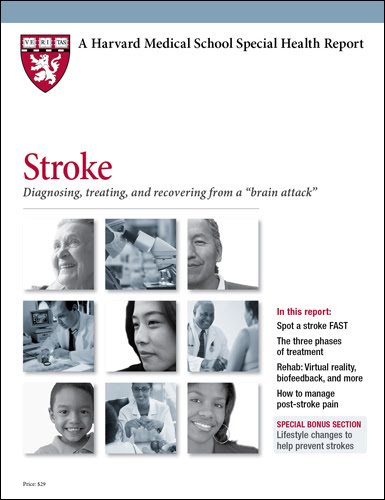Stroke: Diagnosing, treating, and recovering from a "brain attack" - Harvard Health

Today's health topic
DASH diet may lower stroke risk

Following a diet designed to lower your blood pressure may also reduce your odds of having a stroke, according to a study in the April issue of the journal Stroke. The study relied on data from diet questionnaires from more than 74,400 people ages 45 to 84. Researchers created scores based on how closely the participants followed the Dietary Approaches to Stop Hypertension (DASH) diet, a plant-focused diet that emphasizes fruits, vegetables, whole grains, low-fat dairy products, poultry, fish, and nuts. The diet has long been touted for its ability to lower blood pressure, which is one of the leading risk factors for stroke. After a follow-up that lasted an average of nearly 12 years, researchers found that people who more closely followed the DASH diet had a lower risk of ischemic stroke. (About nine in 10 strokes are ischemic; they occur when a clot obstructs a blood vessel supplying the brain.) In addition to lowering blood pressure, the DASH diet may also help prevent stroke by discouraging the buildup of fatty plaque inside arteries, thanks to the diet’s low levels of saturated fat and cholesterol coupled with high levels of antioxidants from plant-based foods. |
|
Get your copy of Stroke
Protect your brain: That’s the strategy that Harvard doctors recommend in this report on preventing and treating stroke. Whether you’ve already had a mini-stroke or a major stroke, or have been warned that your high blood pressure might cause a future stroke, this report provides help and advice.
 |
|
|
Don’t trust this smartphone app to measure your blood pressure |

A popular smartphone app that estimates your blood pressure doesn’t provide reliable readings. In fact, more than three-quarters of people with high blood pressure who use the Instant Blood Pressure app will be falsely reassured that their blood pressure is normal, according to a small study that compared the app results to readings taken with a traditional blood pressure cuff.
To use the app, you put the top edge of your phone on the left side of your chest while holding your right index finger over the smartphone’s camera. The app — which was among the top 50 best-selling iPhone apps for about five months — is no longer for sale, for unclear reasons. But it’s still installed on a vast number of iPhones, and similar apps are still available, according to a research letter published online March 2 by JAMA Internal Medicine. Bottom line: Don’t use any app that uses the phone itself to measure your blood pressure.

Stroke
Featured content:
| • | What is a stroke? |
| • | How strokes affect the brain |
| • | Medical problems that raise stroke risk |
| • | SPECIAL SECTION: Lifestyle changes to help prevent strokes |
| • | Diagnosing a stroke |
| • | ... and more! |
Click here to read more »


























.png)











No hay comentarios:
Publicar un comentario